Mekonnen Asmare Fentahun 1, Prof. Dr. Mahmut Ahsen Savaş 2
1Department of Mechanical Engineering, Faculty of Engineering, Mizan -Tepi University, Ethiopia
2Department of Mechanical Engineering, Faculty of Engineering, Near East University, TRNC
Correspondence to: Mekonnen Asmare Fentahun , Department of Mechanical Engineering, Faculty of Engineering, Mizan -Tepi University, Ethiopia.
| Email: |  |
Copyright © 2018 The Author(s). Published by Scientific & Academic Publishing.
This work is licensed under the Creative Commons Attribution International License (CC BY).
http://creativecommons.org/licenses/by/4.0/

Abstract
Need for higher fuel efficiency, weight minimization, environmental regulations and policies as well as customer demand forces the auto maker companies to focus on developing new materials and re designing of the existing one and selecting materials reasonably. All material industries plastics and polymer composites, as well as steel, aluminum, and magnesium, are operating to respond to the automotive industry changing needs. For decades, advanced plastics and polymer composites have helped the improvement of appearance, functionality, and safety of automobiles while reducing vehicle weight and delivering superior value to customers at the same time. Various materials are used to make cars. The main materials used for making cars, parts and components, along with future trends, are steel, aluminum, magnesium, copper, plastics and carbon fibers. The prime reason for using steel in the body structure is its inherent capability to absorb impact energy in a crash situation. The use of aluminum can potentially reduce the weight of the vehicle body. Recent developments have shown that up to 50% weight saving for the body in white can be achieved by the substitution of steel by aluminum. Magnesium is another light metal that is becoming increasingly common in automotive engineering. It is 33% lighter than aluminum and 75% lighter than steel/cast iron components Titanium has been mainly used in high temperatures zones, and high strength requirement areas, such as exhaust systems, suspension springs, valve springs, valves and connecting rods. Fiber reinforced composites offer a wide range of advantages to the automotive industry. It is because the composite structures are the high strength/low weight ratio. The use of lightweight plastics and composite materials in the automotive industry has been increasing in recent years due to legislative and consumer demands for lighter weight, fuel efficient vehicles. One of the methods to choose best materials for automotive applications is to use material selection charts, which provides the performance index of the materials to suit the requirement and conditions for specific application.
Keywords:
Automotive manufacture, Ashby charts, Metals, Material performance index
Cite this paper: Mekonnen Asmare Fentahun , Prof. Dr. Mahmut Ahsen Savaş , Materials Used in Automotive Manufacture and Material Selection Using Ashby Charts, International Journal of Materials Engineering , Vol. 8 No. 3, 2018, pp. 40-54. doi: 10.5923/j.ijme.20180803.02.
1. Introduction
The importance of materials selection in the product development process has been well recognized since past decades. To develop a systematic method for selecting the best material is not an easy task because the best material is determined by a number of factors that influence the selection process. There are two main reasons why materials selection is required: firstly, to design an existing product for better performance, lower cost, increasing reliability and reduced weight and secondly, to select a material for a new product. Materials selection is a main product design consideration because product’s overall performance is mainly affected and determined by materials selection process [1].The automotive composite materials, reinforced plastics and polymers are among widely preferred alternatives for light weighting of the automobile as they offer enhanced properties such as impact strength, easy mold–ability, improved aesthetics, and reduced weight as compared to conventional automotive components. The main advantages, which offer opportunities in the automotive industry, are their potential for maximum mass reduction of automobile and carbon emission reduction potential by light weighting of the vehicle. The factors restraining the market are high material costs and huge investments in material research activities by companies.The automotive industry is under increasing pressure to meet higher fuel efficiency, environmental and performance demands at competitive costs. All material industries plastics and polymer composites, as well as steel, aluminum, and magnesium, are operating to respond to the automotive industry changing needs. For decades, advanced plastics and polymer composites have helped the improvement of appearance, functionality, and safety of automobiles while reducing vehicle weight and delivering superior value to customers at the same time [2]. New regulations, shifts in consumer preferences, and recent technological innovations are encouraging automotive industry to continue increasing their use of advanced plastics and polymer composites to meet tomorrow’s challenges and opportunities [2]. Composite materials offer an opportunity to significantly reduce the weight of a vehicle while still meeting strength requirements. Today, engineered plastics are fast becoming the future for two industries, chemical and automotive as environmental concerns are increasingly affecting both. To preserve optimum fuel efficiency, automakers are using materials that are more lightweight plastics and polymer based components [2].The automotive sector is under constant pressure to reduce carbon emissions and bring down fuel consumption by reducing the weight of vehicles, with an increase in safety requirements. The underlying reason for this is the need for lower weight, different types of materials, as well a stricter environmental legislation and related traffic regulations [2].
2. Materials in the Automotive Industry an Overview
Various materials are used to make cars. The main materials used for making cars, parts and components, along with future trends, are steel, aluminum, magnesium, copper, plastics and carbon fiber. The main factors for selecting the material, especially for the automobile body, are numerous and include thermal, chemical or mechanical resistance, easy manufacturing and durability [2]. Affordability is an important issue in vehicle manufacturing, which includes factoring in the costs associated with a car’s complete life–cycle, including manufacturing, operating and disposal costs. Composite materials may have big advantages over steel in automobile manufacturing in the future. Composites are considered to make lighter, safer and more fuel efficient vehicles. A composite is composed of high–performance fiber (such as carbon or glass) in a matrix material (epoxy polymer) that, when combined, provides enhanced properties compared with the individual [2]. Carbon fiber composites are equally good or better concerning stiffness and strength. They also do not rust or corrode like steel or aluminum, and they could significantly increase vehicle fuel economy by reducing vehicle weight. The issue with today’s composites is that they have been developed for aerospace applications where the cost is not so critical. Material costs of carbon fiber composites are at least 20 times higher than steel, and the automotive industry is unlikely to use them until the price of carbon fiber drops significantly. Therefore, if we want to choose material with these characteristics, steel is the first choice. There were many developments concerning iron and steel over the past couple of decades that made steel more lightweight, stronger, stiffer and improved other performance characteristics. Applications include not only vehicle bodies, but also engine, chassis, wheels and many other parts (doors, hoods, hatchbacks etc.). Iron and steel form the critical elements of the structure for the vast majority of vehicles, and are low cost materials [2]. The prime reason for using steel in the body structure is its inherent capability to absorb impact energy in a crash situation. Aluminum usage in automotive industry has grown within past years, due to its low density and high specific energy absorption performance and good specific strength. The use of aluminum can potentially reduce the weight of the vehicle body. Recent developments have shown that up to 50% weight saving for the body in white can be achieved by the substitution of steel by aluminum. Aluminum is used for body structures, chassis applications, closures and exterior attachments such as crossbeams, doors or bonnets. Magnesium is another light metal that is becoming increasingly common in automotive engineering. It is 33% lighter than aluminum and 75% lighter than steel/cast iron components [2]. Magnesium alloys have distinct advantages over aluminum that include better manufacturability longer die life and faster solidification. In addition magnesium components have higher machinability. 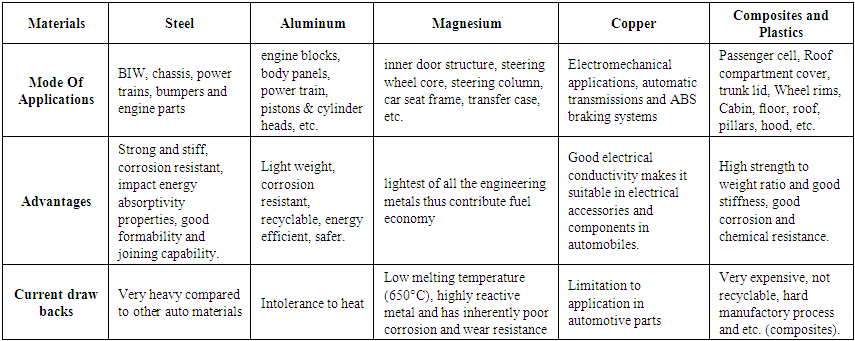 | Table 1. Summary of current automotive applications with mode of application, advantage and drawbacks |
Titanium has been mainly used in high temperatures zones, and high strength requirement areas, such as exhaust systems, suspension springs, valve springs, valves and connecting rods. Fiber reinforced composites offer a wide range of advantages to the automotive industry. It is because the composite structures are the high strength/low weight ratio. Carbon fiber–reinforced or fiber glass reinforced composites offer numerous new design possibilities for structural components in cars. These advanced materials are not only light in weight, but also stiff, strong and durable. The future lightweight materials will be used in the automobile industry. Now, carbon fiber is very expensive, but the automobile industry has been developing affordable carbon fiber, so the future cars will be lighter. Fiber reinforced composites are now being used to make structural and nonstructural components such as seat structures, bumpers, hoods, and fuel tanks [2].
3. The Development of New Automotive Materials and Components
The producers in the automotive industry are expressing more and more interest in the industrial applications of light, strong and thus energy efficient and cleaner solutions, such as composites. This requires innovations in materials, design, production, processing and process automation and, above all, cost effectiveness. The traditional production processes for cars are still focused mainly on the processing of metal chassis and other components. Although plastics are extensively used, the deployment of fiber reinforced composites for high volumes of cars is still in the pioneering phase [2].To develop new automotive materials, components, and systems in the most effective way, the completely automotive supply chain needs to work together. The researches on composite materials, reinforced plastics and polymers have come up with improved material qualities that make them suitable for use in interior, exterior, and under bonnet components of automobiles. The automotive composite materials are used in various automotive components such as bumpers, seating, dashboards, internal and external trims. The careful selection of these automotive materials enables designers to improve durability meet load–bearing requirements, and achieve reduction in vehicle weight [2].The Figure below provides the data on the tensile strength and density of filled plastics, polymer composites, metals, and alloys. As shown in fig.1, many plastics and polymer composites are significantly less dense than most metals and alloys while offering similar tensile strengths. These data illustrate the fundamental physical advantage that many plastics and polymer composites offer over metallic automotive materials: higher strength to weight ratios that can enable automakers to lightweight vehicles while maintaining safety and performance [4].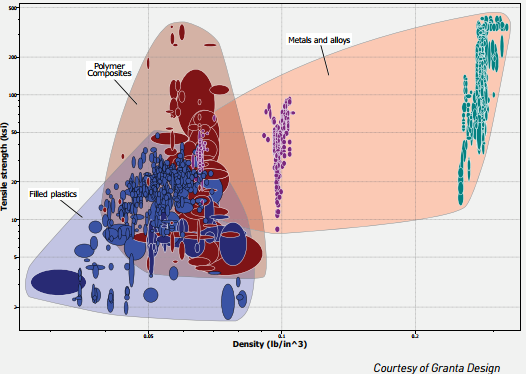 | Figure 1. Tensile strength vs. density for automotive materials [4] |
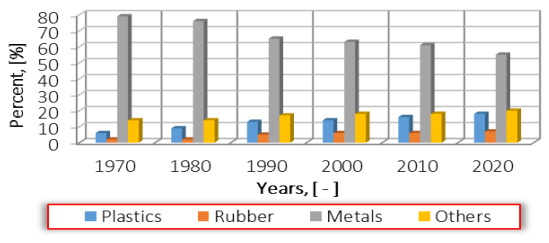 | Figure 2. Change in vehicle composition from 1970 to 2010 [2] |
The use of lightweight plastics and composite materials in the automotive industry has been increasing in recent years due to legislative and consumer demands for lighter weight, fuel efficient vehicles. In some cases, plastics are replacing heavier ferrous materials whereas; in other cases, plastics and composites are being added for consumer comfort purposes. In addition to being lightweight, these materials are also durable and easily molded. Substituting heavier materials with plastics leads to an overall weight reduction. The percent of plastics by mass in an average vehicle has gone from 6% in 1970 up to 16% in 2010 and is expected to reach 18% in 2020 [2].Composite materials currently have high purchase price, but when viewed from a lifecycle perspective they make good economic sense. On top of low weight, composite materials provide strength and rigidity, while fatigue and ageing are not generally seen as problems. Composites also do not rust, and they do not degrade in the same way as metal structures. Another advantage with composite use in chassis structures is that it is possible to create larger integrated structures than with steel. This means fewer joints, which in turn further reduces weight. The researchers say that tomorrow’s vehicles will be made from a bigger mix of materials, with focus on both function and weight [2]. While the plastics and polymer composites industry has been working collaboratively with the automotive industry for many years, barriers remain that limit the use of plastics and polymer composites in vehicles. Plastics and polymer composites continue to deliver significant weight savings to automakers. In addition to their current role, as an excellent choice for light weighting, aesthetics, aerodynamic design and value in many interior and exterior applications, plastics and polymer composites particularly the fiber reinforced composites are also fast becoming a contender in structural applications like body–in–white and chassis components, due to their ability to drastically reduce overall vehicle weight while maintaining or improving safety and performance [2].
4. Requirements of the Materials in Automotive
The materials used in automotive industry need to fulfill several criteria before being approved. Some of the criteria are the results of regulation and legislation with the environmental and safety concerns and some are the requirements of the customers. In many occasions different factors are conflicting and therefore a successful design would only be possible through an optimized and balanced solution [3]. For the foreseeable future, ecological requirements emerging from the social and legal environment- the need to protect the natural environment and use resources sparingly - will almost certainly represent a major factor for change. The following table illustrates how these demands will affect the processes and the materials used in automobile construction [5].The automotive industry is increasingly relying on a systematic approach to materials selection. The choice of materials for a vehicle is the first and most important factor for automotive design. There is a variety of materials that can be used in the automotive body and chassis, but the purpose of design is the main challenge here. For the automobile manufacturers, the most important criteria that a material should meet are [2]:ü Light weight, this criterion is the most important one for an automotive company, in the context of the high emphasis on greenhouse gas reductions, reduction of emissions and improving fuel efficiency.ü Economic effectiveness, having in view that one of the most important consumer driven factors in automotive industry is the cost, that determines whether any new material has an opportunity to be selected for a vehicle component;ü Safety, which criterion have in view the ability to absorb impact energy through controlled failure modes and mechanisms and be survivable for the passengers; andü Recyclability of their products and life cycle considerations, having in view that the most important concerns in automotive industries are the protection of resources and the recycling possibilities, including strategies on research and development targeted on recycling techniques and the development of more easily recyclable materials and their incorporation into the vehicle and its constituent components.Table 2. Requirements on future materials in the automotive industry [5]
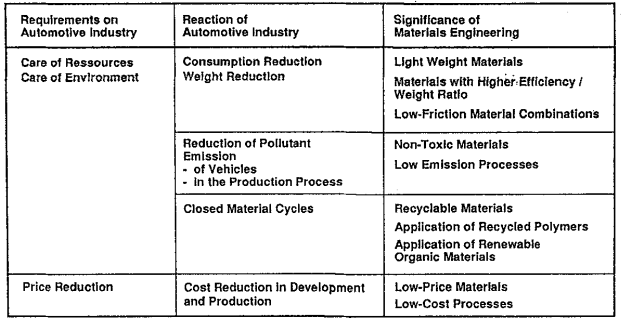 |
| |
|
The weight reduction in the automotive industry can be obtained in three ways:× Replacing materials of high specific weight with lower density materials without reducing rigidity and durability (for example replacement of steel with aluminum, magnesium, composites and foams.× Optimizing the design of load carrying elements and exterior attachments to reduce their weight without any loss in rigidity or functionality; and× Optimizing the production process.By continuing the development of composite materials technologies, the automobile industry is able to create cars increasing their performance and their appearance. The ability to leverage this kind of lightweight material gives a competitive advantage that will benefit the cars, as well as the production process, in the future [2]. However, the single main obstacle in application of lightweight materials is their high cost. Yet the weight reduction is still the most cost effective means to reduce fuel consumption. The cost includes three components [2]:Ÿ The actualŸ Cost of raw materials, manufacturing value added cost and Ÿ The cost to design and test the product.Aluminum and magnesium alloys are certainly more costly than the currently used steel and cast irons. Since the cost may be higher, decisions to select light metals must be justified based on the improved functionality. Meanwhile the high cost is one of the major obstacles in the use of composite materials. By 2030, the automotive industry and society will recognize plastics and polymer composites as preferred material solutions that meet, and in many cases set, automotive performance and sustainability requirements. Plastics and polymer composites provide the weight savings, strength, and versatility the automotive industry needs to meet new standards without sacrificing quality [4].The automotive industry is constantly seeking to improve aesthetics and reduce the weight of vehicles while simultaneously increasing their strength and improving crash performance. However, balancing the feel and appearance of a material with its strength, stiffness, ability to withstand dimensional tolerances, and cost is a critical challenge [4].For vehicle manufacturers and their suppliers, materials have never been more strategic. Materials choice influences cost, safety, risk, weight, market image, and vehicle emissions. Materials knowledge gives competitive advantage: it enables you to meet quality and emissions goals, it is a critical input for virtual product development processes, and it gives you the means to respond quickly to supply chain disruptions and new legislations [4].Plastics and polymer composites, which already dominate vehicle interiors, exteriors, trim, and lighting, are gaining use in other vehicle systems as lightweight, value–producing materials that can meet increasingly challenging automotive requirements. These materials’ many advantages have enabled them to grow to become a significant part of the materials mix in the automotive industry over the past 40 years (figure 3). As the push to lightweight vehicles intensifies, projections indicate that plastics and polymer composites can and should play an even more substantial role in the automotive industry through 2025 and beyond (figure 3) [4].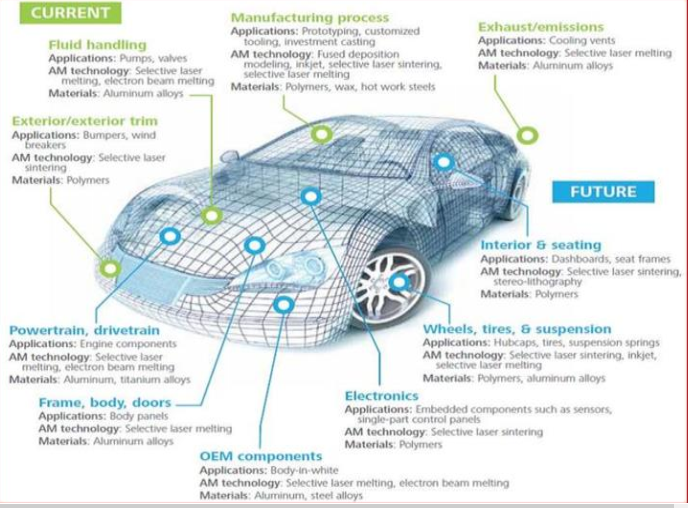 | Figure 3. Current and future tendencies in the automotive industry [2] |
The typical weight distribution in cars is Steel 71% (body panels), Cast iron 15% (engine parts, gear box, axle...), rubber (tires, hoses...) and others include Zink, Copper, Aluminum, polymers etc. [6].
5. Current Materials in Use in Automotive
The categories of current materials used in automotive industry such as metals, composites and others are discussed below MetalsSteelAdvanced iron and steel technologies have seen considerable development over the past decade and are frequently included into new designs and redesigns by all automakers. The steel industry and component suppliers are investing heavily in innovation. The result of the investment is numerous examples of successful, cost-effective use of stainless steel, new formulations of iron, high-strength steels, and an associated variety of new design, fabrication, and assembly techniques. Applications of steel in automotive industry include not only vehicle bodies, but also engine, chassis, wheels and many other parts. The usages commonly demonstrate weight reduction plus simultaneous improvements in strength, stiffness, and other structural performance characteristics. While body, chassis, engine and other powertrain components made of ferrous materials comprise the largest part of a vehicle by mass, lightweight steel and iron technologies compete with potential substitutes in all of these applications [3].Mass reduction through advanced use of iron and steel is significant (ferrous materials), because they are the dominant material. Iron and steel form the critical elements of structure for the vast majority of vehicles, and are low-cost materials with an extensive experience base and familiarity to the industry (steel and cast iron contribute about 86% total weight of the automobile) [3].The use of high-strength steels (HSS), many versions of which are referred to as high-strength, low-alloy (HSLA) steels in the past decades increases dramatically in the automotive sector. One of the applications of a high-strength, low-alloy (HSLA) steels is in Ultra-light Steel Auto Body (ULSAB) which demonstrated a 19% mass reduction in a body structure that had superior strength and structural performance (including crashworthiness) along with a reduced parts count and net manufacturing cost savings compared to a conventional steel body. [USAB, 1998] Comparable mass reductions and other benefits were achieved for doors, hoods, decklids, and hatchbacks. Improved steel materials and forming processes allow a significant optimization of vehicle body structures and components [3]. The prime reason for using steel in the body structure of an automotive is its inherent capability to absorb impact energy in a crash situation [Marsh, 2000]. This, in combination with the good formability and joining capability, makes these materials often a first choice for the designer of the body-in-white (BIW) structure.High-strength steel (HSS) is based on alloys that are categorized on the basis of yield strength. Standard HSS has a yield strength between 210 MPa and 550 MPa; ultra-high strength steel (UHSS) has a yield strength higher than 550 MPa. High-strength steels can cost as much as 50% more than traditional mild steels, but they allow use of lower thicknesses than milder steels for achieving needed part performance specifications. Recently Steel suppliers are developing steels with a range of properties that give engineers more flexibility in selecting an ideal grade of steel for any given application [3].Stainless steel is a material of choice due to passivity and resistance to corrosion. Some of the stainless steel grades suggested for automotive are as follows: [Cunat, 2000].1. Duplex austenitic-ferritic stainless steel.The most commonly used duplex grade is 0.02% C – 22% Cr – 5.5% Ni – 3% Mo – 0.15% N alloy.2. Austenitic stainless steel.These steels have chromium (18 to 30 per cent) and nickel (6 to 20 per cent) as the major alloying elements. The austenitic phase is stabilized by the presence of a sufficient amount of nickel. The principal characteristics are the ductile austenitic condition, rapid hardenability by cold working and excellent corrosion resistance. One of the most commonly used grade for structural applications is the 0.02% C – 17.5% Cr – 7% Ni – 0.15% N alloy.(1) In the solution annealed condition, (2) In the cold worked condition C 850 (8502)<1000) (3) In the cold worked condition: C 1000 (10002)<1150), (4) In the solution heat treated condition, (5) In the precipitation heat treated condition.The specific stiffness of Stainless Steel is very similar to that of aluminum alloy and the HSLA steel, which means that the three materials can all be considered as “light materials”. The specific strength of the austenitic Stainless Steel in the cold worked condition is much higher than the one for the other materials. The specific strength of different steel and aluminum are compared in the Table 3.Table 3. Specific Strength of Stainless Steels, 6061 Aluminum and High Strength Steel [Source: Cunat, 2000]
 |
| |
|
Crashworthiness energy absorption is a key property of the material used for structural components or complete structures so-called “space frames”. Austenitic Stainless Steels i.e. Fe - Cr - Ni containing alloys have the advantage over aluminum alloys and carbon steels of being highly strain rate sensitive. This means that the faster the loading is applied the more the material will resist deformation. In addition to that, Stainless Steel has the capability to collapse progressively in a controlled and predetermined manner which is desirable in automotive application [3].AluminumAluminum usage in automotive applications has grown more than 80% in the past years. Aluminium castings have been applied to various automobile parts for a long period. As a key trend, the material for engine blocks, which is one of the heavier parts, is being switched from cast iron to aluminium resulting in significant weight reduction. Aluminum engine blocks are expected to increase at least to about 50% of all cars [7]. Aluminium castings find the most widespread use in automobile. In automotive power train, aluminium castings have been used for almost 100% of pistons, about 75% of cylinder heads, 85% of intake manifolds and transmission (other parts-rear axle, differential housings and drive shafts etc.) For chassis applications, aluminium castings are used for about 40% of wheels, and for brackets, brake components, suspension (control arms, supports), steering components (air bag supports, steering shafts, knuckles, housings, wheels) and instrument panels. Recently, development effort to apply wrought aluminium is becoming more active than applying aluminium castings. Forged wheels have been used where the loading conditions are more extreme and where higher mechanical properties are required. Wrought aluminium is also finding applications in heat shields, bumper reinforcements, air bag housings, pneumatic systems, sumps, seat frames, side impact panels, to mention but a few. Aluminium alloys have also found extensive application in heat exchangers [7]. There are a broad range of opportunities for employing aluminum in automotive powertrain, chassis, and body structures. The use of aluminum offers considerable potential to reduce the weight of an automobile body. In current steel construction, the vehicle consists of stamped body panels spot welded together (body-in-white) to which stamped steel fenders, doors, hood, and deck lid are bolted. There are two methods of designing and manufacturing an aluminum body structure; one is similar to the current steel construction using stamped option and the other system which involves castings, extrusions, and stampings welded together, known as space frame. [Cole et al, 1995]Aluminum alloys for body-in-white applicationsUp to now the growth of aluminum in the automotive industry has been in the use of castings for engine, transmission and wheel applications, and in heat exchangers. The cost of aluminum and price stability remains its biggest impediment (challenge) for its use in large-scale sheet applications. Aluminum industry has targeted the automotive industry for future growth and has devoted significant resources to support this effort. The body-in-white (BIW) offers the greatest scope for weight reduction with using large amount of aluminum. Recent developments have shown that up to 50% weight saving for the BIW can be achieved by the substitution of steel by aluminum [Scott, 1995]. This can result in a 20–30% total vehicle weight reduction when added to other reduction opportunities.MagnesiumMagnesium is the lightest of all the engineering metals having a density of 1.74 g/cm3, which are 33% lighter than aluminium (2.7 g/cm3) and 75% lighter than steel (7.86 g/cm3) /cast-iron components. The corrosion resistance of modern, high-purity magnesium alloys is better than that of conventional aluminium die-cast alloys. Magnesium components have many mechanical/physical property disadvantages that require unique design for application to automotive products. Although it’s tensile yield strength is about the same, magnesium has lower ultimate tensile strength, fatigue strength, and creep strength compared to Aluminium. The modulus and hardness of magnesium alloys is lower than aluminium and the thermal expansion coefficient is greater. However, it should be noted that suitable ribbing and supports often can overcome the strength and modulus limitations [3]. Despite the above issues Magnesium alloys have distinct advantages over aluminium that could not be dismissed. These include better manufacturability, longer die life and faster solidification due to lower latent heat. Therefore more castings can be produced per unit time compared to aluminium. Magnesium components have higher machinability. Magnesium components can be produced with improved dimensionality and surface quality, and smaller draft angles compared to aluminium. The capability of magnesium to be hot chamber die cast can reduce casting scrap by reducing dross and can limit gas and oxide inclusions while allowing more consistent melt temperature [3].Mechanical properties of Mg alloysSpecific strength and specific stiffness of materials and structures are important for the design of weight saving components. Weight saving is particularly important for automotive bodies, components and other products where energy consumption and power limitations are a major concern [Tkachenko et. al, 2006]. The specific strength and specific stiffness of magnesium are compared with aluminium and iron in Figure 5. There is little difference between the specific stiffness between Mg, Al and Fe as seen in Figure 5. The specific stiffness of Al and Fe is higher than Mg only in the ratio of 0.69% and 3.7%, respectively. On the other hand, the specific strength of Mg is considerably higher than that of Al and Fe in the ratio of 14.1% and 67.7%, respectively. [Kulekci, 2008]Magnesium can be used in automotive in, inner door structure, steering wheel core, steering column, car seat frame, transfer case, wheel rims, clutch case, Brackets for air comfort system compressor, steering booster pump and generator and instrumental panel etc. [8]Table 4. Properties of Mg, Al, Fe [Source: Davies, 2003]
 |
| |
|
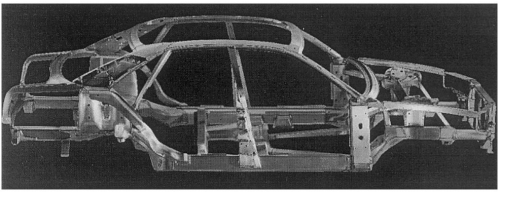 | Figure 4. Aluminium extruded space frame BIW architecture, Alcoa-Audi A8 [7] |
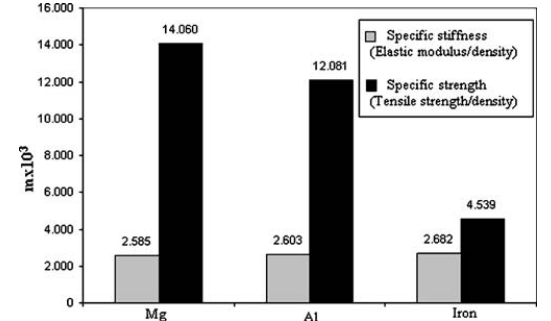 | Figure 5. Comparison of basic structural properties of magnesium with Al and iron [3] |
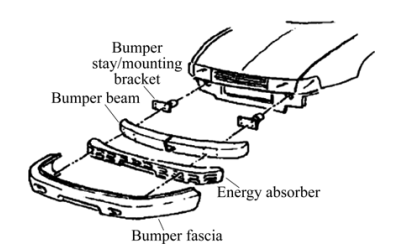 | Figure 6. Automotive bumper parts with potential application of Carbon fiber reinforced composite (CFRC) [1] |
Composites and plastics Composite materials may someday have big advantages over steel in automobile manufacturing. Composites are being considered to make lighter, safer and more fuel-efficient vehicles. A composite is composed of a high-performance fiber (such as carbon or glass) in a matrix material (epoxy polymer) that when combined provides enhanced properties compared with the individual materials by themselves. Carbon-fiber composites weigh about one-fifth as much as steel, but are as good or better in terms of stiffness and strength. They also do not rust or corrode like steel or aluminum, and they could significantly increase vehicle fuel economy by reducing vehicle weight by as much as 60 percent, according to the Oak Ridge National Laboratory (ORNL).With composite materials, we get high strength-to-weight and stiffness-to-weight ratios, as well as excellent energy-absorbing capability per mass [9]. Strength and stiffness factors are why composites are currently used in aerospace applications, which also require a material that is extremely light. And compared to single-layered steel in cars, multiple-layer composite laminates can be designed to absorb more energy in a crash. However, the use of these materials in the automotive industry has been very limited partly because of the costs associated with the materials and manufacturing, [9]. In modern word composites are used in all fields like Automotive, aerospace, construction industry, entertainment industry etc. [10].Characteristics of compositesü They are rigid with high strength to weight ratioü Good electrical resistanceü Resistance to chemical and weather is highü They have good stiffness (related to automobile skin to limit buckling)ü Good corrosion resistance.Why composites in automotive?× To improve fuel efficiency by reducing mass of the vehicle× To improve safety and crashworthiness× To enhance styling and part consolidation× To provide aerodynamic designThe applications of CFRP (Carbon fiber reinforced polymer/plastics) includes Passenger cell, Roof compartment cover, trunk lid, Wheel rims, Cabin, floor, roof, pillars, hood, Front and rear bumpers, Instrument panel, inner door modules & etc. [11]. Additionally dashboard, gauges, dials, switches, air conditioner vents, door handles, floor mats, seat belts, airbags and many other parts are all made from different types of plastics. In addition to the dashboard parts, many of the tiny parts inside the engine, such as the handle on the oil dipstick, are also made of plastic. Because of their lightweight nature, plastics are being increasingly used in body structures and in engines during automotive manufacturing. One of the important materials in plastics is rubber which is used to manufacturing of tires. The rubber tire protects the rest of the wheel and its internal parts from wearing down, which can be good for fuel mileage and road safety. In addition to the all-important tires, parts such as wiper blades, engine mounts, seals, hoses and belts are also made from rubber. Rubber is a plastic which is durable, cheap and flexible material that has a wide array of uses in automobiles [12]. The other material used in automotive is glass. Obviously, its primary use is to create windshields to see properly while remaining safe from any airborne objects. It's also used to create rear and side-view mirrors to boost a view of what's around while driving. In modern cars glasses can be used to create navigation screens and lenses for back-up cameras to allow drivers to have an even better view of what's behind them [12].
6. Material Selection and Indices of Automotive Materials
Material selectionThere are four basic steps to be followed while selecting materials for specific purposes/ requirements [13].1) Translation: express design requirements as constraints and objectives2) Screening: eliminate materials that cannot do the job3) Ranking: find materials that best do the job4) Supporting Info: handbooks, expert systems, web, etc.Step 1) Translation:An engineering component has boundary condition for Materials SelectionI. Function: to carry load, transmit heat, contain a pressure, etc..(What does the component do?)II. Objectives: as cheap as possible, light, safe, strong, etc…(What is to be Maximized or Minimized?)III. Constraints: subject to constraints such as carry load without failure, certain dimensions are fixed; cost is within limits etc…ü What non-negotiable conditions are to be met? (Rigid)ü What negotiable but desirable conditions? (Soft)IV. Free Variables: materials choice, cross-section area, thickness, and length are freeWhich design variables are free? (Variables which can be changed)Step 2) Screening: Is a method to evaluate large range of materials by the help of material Bar charts, material Property Charts (density vs. Young’s Modulus…), screen on constraints, rank on objectives etc.Step 3) Ranking: What if multiple materials remain after screening?ü Rank on Objectivesü Objectives define performance metricsStep 4) Selection: select then verify with any supporting materials.Generally two concepts are used in the selection procedure:1. Materials Performance Index: Combination of material properties that characterize the performance of a material in a given application (Ashby).Performance of a component/structure is specified by:i. Functional requirements (function) (F) e.g. carry loads, transmit energy, store energy etc.ii. Geometry, (G)iii. Materials properties, (M)Performance:P = f [(functional requirements, F); (geometry, G); (materials properties, M)]P =f (F, G, M)× Optimum design is selection of a material which maximize (strength, stiffness) or minimize (weight, cost) the performance, P. or material property.× In many cases, the function, geometry and materials properties are independent of each other and are said to be separable.P = f1 (F) × f2 (G) × f3 (M)This means that the optimum selection of a material is independent of the details of the design. It is the same for all geometries and values of functional requirements.Performance is maximized by maximizing f3 (M) and is called “Performance Index, M.Therefore: materials for automotive use can be selected based on the above mentioned approach assuming the body panel and parts of the automobile as strong and stiff plate.
7. Deriving Performance Index for Strong and Stiff Panel
A) Design Requirements for a Light, Strong PanelWhere: 𝛿 = Flexural strength, F = applied load, L = length of the plate, b = width, d =thickness.Function: to support load without bendingObjective: to minimize mass (m) of the panelConstraints: geometrical constraints (b, L), functional constraints (F) Free variables: d (thickness) and material choice.è Mass of the panel m = ρAL = ρbdL (objective function) …………………….…….….… (a)Flexural strength/stress  ……………………….……….….….……...…….…………………. (b)From equation (a)
……………………….……….….….……...…….…………………. (b)From equation (a)  substitute to equation (b)
substitute to equation (b) then solving for Mass (m) gives us
then solving for Mass (m) gives us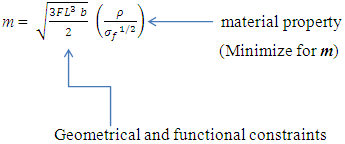 Or maximize performance index,
Or maximize performance index,  (for strong plate)B) Stiff panel:Function: to support load without bendingObjective: to minimize mass (m) of the panelConstraints: geometrical constraints (b, L), bending stiffness (S) specifiedFree variables: panel thickness (d) and material choices Mass of the panel: m = A L ρ = b d L ρ…………(a) (objective function)Bending stiffness:
(for strong plate)B) Stiff panel:Function: to support load without bendingObjective: to minimize mass (m) of the panelConstraints: geometrical constraints (b, L), bending stiffness (S) specifiedFree variables: panel thickness (d) and material choices Mass of the panel: m = A L ρ = b d L ρ…………(a) (objective function)Bending stiffness:  where C is a constant that depends only on the distribution of the loads, E is the young’s modulus, I is second moment of area and L is the length of the plane and I is given by
where C is a constant that depends only on the distribution of the loads, E is the young’s modulus, I is second moment of area and L is the length of the plane and I is given by  substitute to bending stiffness formula
substitute to bending stiffness formula  solve for d, d =
solve for d, d =  ……………(c) substitute to mass formula.
……………(c) substitute to mass formula. then
then 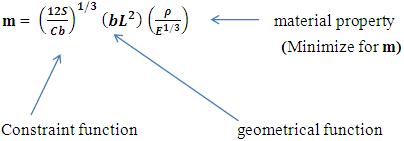 Therefore minimize the material property or maximize the index,
Therefore minimize the material property or maximize the index,  (for stiff plate) Similarly 1.
(for stiff plate) Similarly 1.  index guiding for minimum cost design of strong plates where Cm is material price/kg.2.
index guiding for minimum cost design of strong plates where Cm is material price/kg.2.  index guiding for minimum energy design of strong plates 3.
index guiding for minimum energy design of strong plates 3.  index guiding for minimum energy design of stiff plates4.
index guiding for minimum energy design of stiff plates4.  index guiding for minimum cost design of stiff plates2. Materials Selection Charts: Plots of materials properties that form the maximizing factorsThe selection of the optimum material is made simpler by the use of “Materials Selection Charts”. Materials selection charts are plots of the properties that form the maximizing factors. The performance index is made up of 2 properties (e.g.; E & ρ). The material selection chart is then created with axis (log by default) of E and ρ [13].The performance index (P) plot is a diagonal line on the chart. For the performance index P = E/ρ, we take log;
index guiding for minimum cost design of stiff plates2. Materials Selection Charts: Plots of materials properties that form the maximizing factorsThe selection of the optimum material is made simpler by the use of “Materials Selection Charts”. Materials selection charts are plots of the properties that form the maximizing factors. The performance index is made up of 2 properties (e.g.; E & ρ). The material selection chart is then created with axis (log by default) of E and ρ [13].The performance index (P) plot is a diagonal line on the chart. For the performance index P = E/ρ, we take log;  =
=  (A line of slope 1 on the chart describes the index), similarly for P = E1/2/ ρ and E1/3 / ρ, gives lines with slope 2 and 3 respectively and they are called “design guidelines” [13].Below charts for strength–density, strength–energy content, strength–relative cost, are given [Adopted from Michael F. Ashby].
(A line of slope 1 on the chart describes the index), similarly for P = E1/2/ ρ and E1/3 / ρ, gives lines with slope 2 and 3 respectively and they are called “design guidelines” [13].Below charts for strength–density, strength–energy content, strength–relative cost, are given [Adopted from Michael F. Ashby]. | Figure 7. a) Plate of length (L) subjected to force (F) and b) front view [14] |
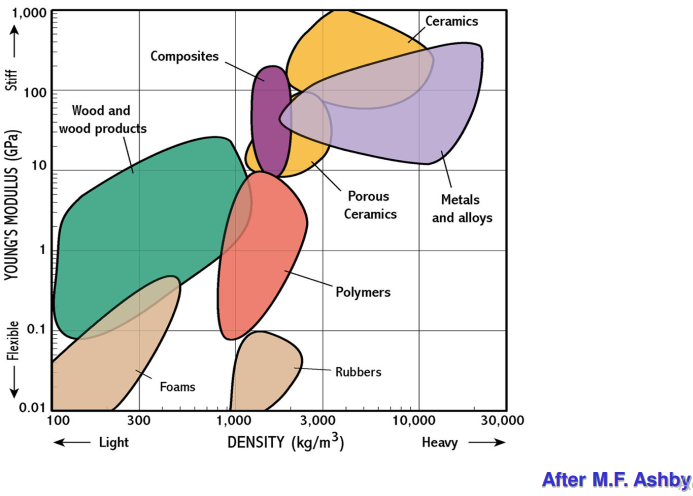 | Figure 8. Illustration of Young’s modulus (E) Vs. Density (ρ) of material selection charts [13] |
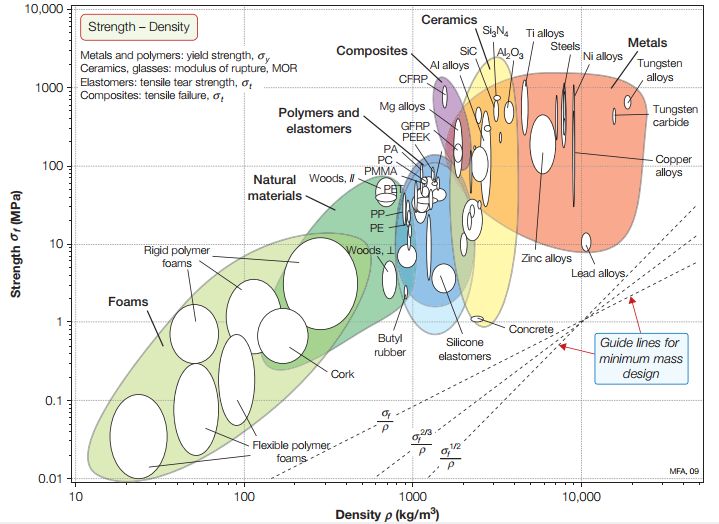 | Figure 9. Strength  plotted against density ρ. (Michael F. Ashby) plotted against density ρ. (Michael F. Ashby) |
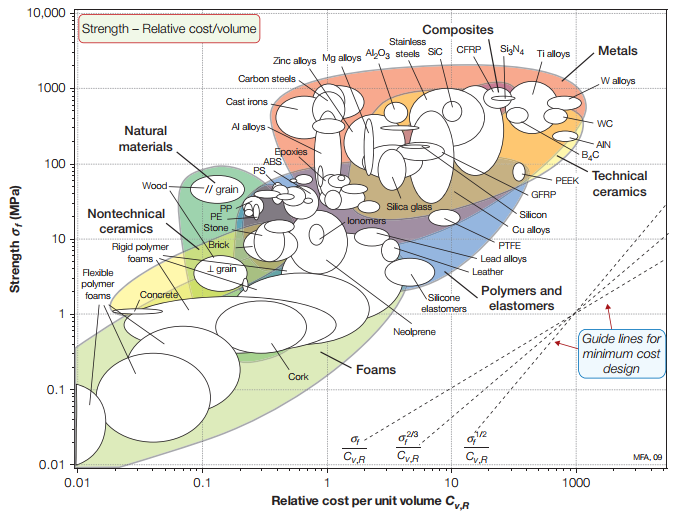 | Figure 10. Strength  plotted against relative cost per unit volume Cv,R. (Michael F. Ashby) plotted against relative cost per unit volume Cv,R. (Michael F. Ashby) |
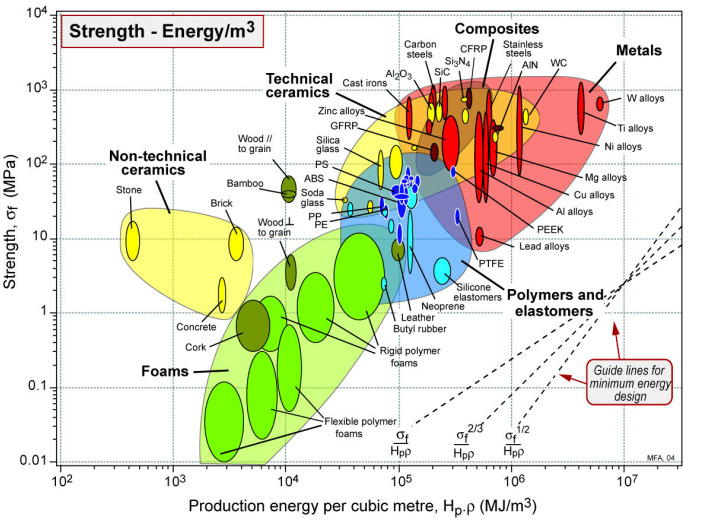 | Figure 11. Strength  plotted against production energy per cubic meter. (Michael F. Ashby) plotted against production energy per cubic meter. (Michael F. Ashby) |
8. Examination of Charts of Automotive Materials
Table 5. Strength vs. density chart (Figure 9)
 |
| |
|
Table 6. Strength vs. Relative cost (figure 10)
 |
| |
|
Table 7. Strength vs. Energy content (figure 11)
 |
| |
|
9. Conclusions
Materials selection in the automotive industry is governed by the demands emerging from customers’ expectations and legal requirements. The need for light weight, energy efficient, environmental friendly and cheap cost materials are in great demand by automotive industries. The development of materials application in the near future will be determined by ecological needs like consumption reduction and used vehicle disposal and by the necessity to reduce costs. Best material is determined by a number of factors that influence the selection process. The reason why material section needed is to design an existing product for better performance, lower cost, increasing reliability and reduced weight and to select a material for a new product. Various materials are used in auto industry like steel, aluminum, magnesium, copper, plastics and carbon fiber. The main factors for selecting the material, especially for the automobile body, are numerous and include thermal, chemical or mechanical resistance, easy manufacturing, durability and many other mechanical properties including cost and availability of course. The producers in the automotive industry are expressing more and more interest in the industrial applications of light, strong and thus energy efficient and cleaner solutions, such as composites. Based on the examination of the charts it’s found to be that CFRP is light and have high yield strength while steels are very heavy and have high yield strength. This points out increasing usage of CFRP in automotive reduces overall weight and fuel consumption as well. It is also seen that CFRP needs more energy in the production (might be one reason for their expensiveness) and CFRP’s are the most expensive automotive materials.
10. Recommendations
ü In the selection process a better result would have been gained if software is used instead of charts.ü The material cost is fluctuating therefore to get good material property the cost should be updated frequently.
References
| [1] | Material selection of polymeric composite automotive bumper beam using analytical hierarchy process by A. Hambali, S. M. Sapuan, N. Ismail, Y. Nukman. (Date Retrieved: April 29, 2018). |
| [2] | Systematic approach on materials selection in the automotive industry for making vehicles lighter, safer and more fuel–efficient, Mihai-Paul Todor, Imre Kiss University Politehnica Timisoara, Faculty of Engineering Hunedoara, Romania. (Date Retrieved: April 29, 2018). |
| [3] | Materials in Automotive Application, State of the Art and Prospects, A research gate publication by Elaheh Ghassemieh University of Sunderland. (Date Retrieved: April 29, 2018). |
| [4] | Plastics and Polymer Composites Technology Roadmap for Automotive Markets, Plastics Division of the American Chemistry Council, 2014 https://0x9.me/fju6A (Date Retrieved: May 2, 2018). |
| [5] | Materials used in automobile manufacture – current state and perspectives M. Wilhelm (Date Retrieved: May 17, 2018). |
| [6] | Material selection and design, Moonsub Shib 2007, 2008. (Date Retrieved: May 17, 2018). |
| [7] | Recent development in aluminium alloys for the automotive industry, W.S. Miller A, L. Zhuang a, J. Bottema a, A.J. Wittebrood a, P. De Smet b, A. Haszler c, A. Vieregge. (Date Retrieved: May 19, 2018). |
| [8] | Magnesium and its alloys applications in automotive industry Mustafa Kemal Kulekci. (Date Retrieved: May 19, 2018). |
| [9] | https://mech.utah.edu/composites_cars/ (Date Retrieved: May 21, 2018). |
| [10] | Applications of composite materials in the automobile industry by praveengouda patil, 2009/10. (Date Retrieved: May 21, 2018). |
| [11] | Polymer composites for automotive sustainability, European technology platform for sustainable chemistry. (Date Retrieved: May 21, 2018). |
| [12] | https://0x9.me/gywSk (Date Retrieved: May 21, 2018). |
| [13] | Michael F. Ashby, Materials selection in mechanical design fourth edition, butterworth-heinemann publication, October 2010. (Date Retrieved: May 22, 2018). |
| [14] | https://en.wikipedia.org/wiki/Flexural_strength (Date Retrieved: July 7, 2018). |










 ……………………….……….….….……...…….…………………. (b)From equation (a)
……………………….……….….….……...…….…………………. (b)From equation (a)  substitute to equation (b)
substitute to equation (b) then solving for Mass (m) gives us
then solving for Mass (m) gives us Or maximize performance index,
Or maximize performance index,  (for strong plate)B) Stiff panel:Function: to support load without bendingObjective: to minimize mass (m) of the panelConstraints: geometrical constraints (b, L), bending stiffness (S) specifiedFree variables: panel thickness (d) and material choices Mass of the panel: m = A L ρ = b d L ρ…………(a) (objective function)Bending stiffness:
(for strong plate)B) Stiff panel:Function: to support load without bendingObjective: to minimize mass (m) of the panelConstraints: geometrical constraints (b, L), bending stiffness (S) specifiedFree variables: panel thickness (d) and material choices Mass of the panel: m = A L ρ = b d L ρ…………(a) (objective function)Bending stiffness:  where C is a constant that depends only on the distribution of the loads, E is the young’s modulus, I is second moment of area and L is the length of the plane and I is given by
where C is a constant that depends only on the distribution of the loads, E is the young’s modulus, I is second moment of area and L is the length of the plane and I is given by  substitute to bending stiffness formula
substitute to bending stiffness formula  solve for d, d =
solve for d, d =  ……………(c) substitute to mass formula.
……………(c) substitute to mass formula. then
then  Therefore minimize the material property or maximize the index,
Therefore minimize the material property or maximize the index,  (for stiff plate) Similarly 1.
(for stiff plate) Similarly 1.  index guiding for minimum cost design of strong plates where Cm is material price/kg.2.
index guiding for minimum cost design of strong plates where Cm is material price/kg.2.  index guiding for minimum energy design of strong plates 3.
index guiding for minimum energy design of strong plates 3.  index guiding for minimum energy design of stiff plates4.
index guiding for minimum energy design of stiff plates4.  index guiding for minimum cost design of stiff plates2. Materials Selection Charts: Plots of materials properties that form the maximizing factorsThe selection of the optimum material is made simpler by the use of “Materials Selection Charts”. Materials selection charts are plots of the properties that form the maximizing factors. The performance index is made up of 2 properties (e.g.; E & ρ). The material selection chart is then created with axis (log by default) of E and ρ [13].The performance index (P) plot is a diagonal line on the chart. For the performance index P = E/ρ, we take log;
index guiding for minimum cost design of stiff plates2. Materials Selection Charts: Plots of materials properties that form the maximizing factorsThe selection of the optimum material is made simpler by the use of “Materials Selection Charts”. Materials selection charts are plots of the properties that form the maximizing factors. The performance index is made up of 2 properties (e.g.; E & ρ). The material selection chart is then created with axis (log by default) of E and ρ [13].The performance index (P) plot is a diagonal line on the chart. For the performance index P = E/ρ, we take log;  =
=  (A line of slope 1 on the chart describes the index), similarly for P = E1/2/ ρ and E1/3 / ρ, gives lines with slope 2 and 3 respectively and they are called “design guidelines” [13].Below charts for strength–density, strength–energy content, strength–relative cost, are given [Adopted from Michael F. Ashby].
(A line of slope 1 on the chart describes the index), similarly for P = E1/2/ ρ and E1/3 / ρ, gives lines with slope 2 and 3 respectively and they are called “design guidelines” [13].Below charts for strength–density, strength–energy content, strength–relative cost, are given [Adopted from Michael F. Ashby].


 plotted against density ρ. (Michael F. Ashby)
plotted against density ρ. (Michael F. Ashby)
 plotted against relative cost per unit volume Cv,R. (Michael F. Ashby)
plotted against relative cost per unit volume Cv,R. (Michael F. Ashby)
 plotted against production energy per cubic meter. (Michael F. Ashby)
plotted against production energy per cubic meter. (Michael F. Ashby) Abstract
Abstract Reference
Reference Full-Text PDF
Full-Text PDF Full-text HTML
Full-text HTML




